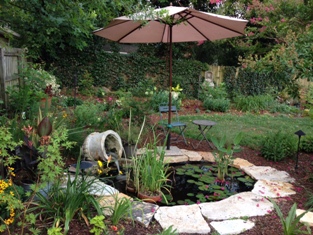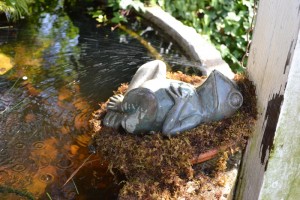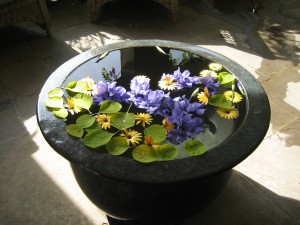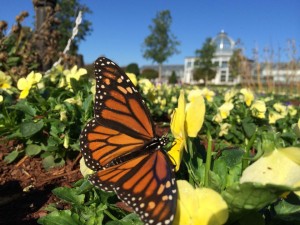Water Gardens Just for Fun

A toppled urn inspires this backyard water garden, while an umbrella shades visitors and lessens algae growth. Photo by George Cowart
Just add water!
A water garden or water feature is more than a landscape decoration. It’s a palette for artistic expression and, when well planned, an uplifting intersection with nature.
“Something about water attracts people,” said George Cowart, horticulture manager at Lewis Ginter Botanical Garden. “Water and the sound [of moving water] are relaxing and entertaining. And for gardeners and horticulturists, water features are another venue for plants we don’t already have in our garden.”
Cowart is a do-it-yourselfer who enjoys morphing ordinary containers into extraordinary water features. Most anything that holds liquid can be repurposed as a water-garden container, from glazed urns and galvanized washtubs to feed-and-seed stock tanks and vintage sinks. If a container holds the imagination, but not water, Cowart suggests a simple solution: add a plastic liner or apply sealant. Just be certain that it’s safe for plants and wildlife.
Creative expression continues with the display, whether it’s a still water garden or a bubbling fountain. Multiple water pots vertically stacked in ragged progression are eye-catchers, as are themed gardens, like fairy or tropical water gardens complemented with decorative ornaments and collectibles. Containers in unexpected places, such as nestled in an old tree stump, entice passers-by to pause, reflect and enjoy. They’re dramatic additions indoors, too, as table centerpieces, bathroom showpieces, office decoratives and foyer accents.
Water features positioned on unexpected planes offer another element of interest. For example, a fountain laid on the ground horizontally (versus vertically) can be configured so water continually empties out of its mouth into an in-ground reservoir for recirculation.

Fearington Village in Pittsboro, N.C. uses decorative frog as fountain in water garden. Photo by Grace Chapman
“It provides mystery about how it was made and where the water is going,” Cowart said.
Originality doesn’t stop with installation; finishing touches are equally important. Rather than covering the base of outdoor containers with traditional mulch, gravel or slate pieces, a water gardener can experiment with decorative glass stones that catch the sun’s rays or pieces of broken mosaic tiles that provide robust color. Mounting miniature spotlights or uplights emphasizes these artistic elements and water movement, while extending viewing pleasure into the evening hours.

Flowers with seasonal interest float in a still-water garden at Chanticleer Gardens in Wayne, Pa. Photo by Grace Chapman
Personalization continues with the plethora of aquatic plants now available at local retailers. Cowart prefers lotus, whose gorgeous summer blooms can be show-stoppers. Water lilies run the gamut of size and color, while papyrus prompts conversation about its ancient origins. Small fish provide motion and interest in circulating ponds, but it’s wise to research their needs before purchase.
As with soil-based gardens, water gardens offer their own set of challenges. Evaporation increases in the heat of summer, so regular additions of water may be necessary. If algae levels start to rise, Cowart suggests moving the container to a shadier spot, if possible, or adding a decorative umbrella so the sun can’t nurture algae growth. Another option is to cover at least two-thirds of the surface with plant material or use algae-control pellets that inhibit growth in an environmentally safe manner. Standing water can become a breeding ground for mosquitoes, so consider adding a bubbler or similar element that creates water movement.
Water gardens offer an educational aspect, too. A starter pond is a fun way for youngsters to experiment with science and explore nature, especially when the water attracts birds and curious wildlife. It not only fosters respect for a precious natural resource, it nurtures a love for (water) gardening.
Editor’s Note: This article first published on Richmond.com on July 12, 2015.
